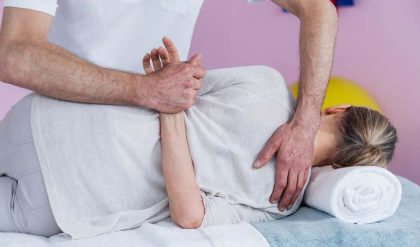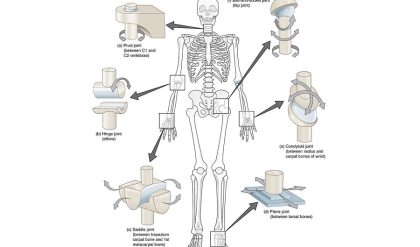I don’t write about structure that often on this blog. That is not because I don’t think structure is an important determinant of how we move and feel. Structure is incredibly important. It’s just that, unlike function, structure is pretty tough to change significantly in the short term. The best example of the stability of structure is the bones. Here are some brief thoughts about the importance of skeletal structure as a determinant of movement quality.
Why skeletal shape matters
The shape of the bones at a particular joint will determine the neutral position for that joint. I am going to define “neutral” as a mechanically optimal position for a wide variety of functions, such as moving in any direction, or being capable of sustaining heavy compressive forces with maximum stability and safety. For example, when the shoulder joint is in a neutral position, the ball of the humerus is well located in the socket of the scapula so that arm can move left, right, up and down without running out of room in the joint or impinging bone on bone. And it can withstand a compressive force down the shaft and transfer it to the scapula with a minimum of shearing forces and risk for damage.
Optimal alignment or posture for a certain function is partly a result of having as many joints in neutral as possible at any one time. And the shape of the bones will determine how many of your joints you can keep in neutral at the same time in a particular functional task. Here’s a very simple example. An internal tibial torsion means that the shape of the tibia bone tends to twist inward as it moves down from the knee to the ankle. If this is the case, then it is impossible to have the knee and ankle pointing directly forward and in neutral at the same. Any effort to point the knee directly forward will tend to point the neutral ankle a little inward, causing pigeon toes.
Another commonly identified bony variation is hip anteversion. Someone with hip anteversion has a particular angle of the femoral neck which causes the lower end of the femur to rotate inward while the femoral head is centered in the hip socket. A person with an anteverted hip will stand with their knees pointed inward, and be able to demonstrate a large range of motion into internal rotation with very little external rotation. This makes it very easy for them to sit in the “W” position.
Personally I have the opposite situation – my hips are relatively retroverted. This makes it impossible for me to do various movements that require a significant amount of internal rotation at the hip that I can see other people doing quite easily. My sensation as I try to do these movements is not that any muscular tightness is preventing me, but instead that I would literally have to dislocate some joints to do the movements.
Of course, these bony asymmetries are not “conditions” that you either have or you don’t. They all exist on a spectrum, and they are not limited to the tibia and femur. Every bone in the body can be shaped relatively closer or further from an optimal shape for certain functions.
Based on this logic and my own observations with clients and myself, the shape of the skeleton is a huge determinant of functional or athletic ability. I think part of the reason we can recognize a great athlete by a few simple movements is not just the quality of their function but the quality of their structure. An optimal skeletal structure makes it quite easy and natural to place all of the joints in neutral positions at the same time. People with skeletons that do not allow them to do so must make compromises, and these reveal themselves in suboptimal alignment, decreased ranges of motion, and reduced efficiency.
Practical implications
So what can we do with this information? Other than form some plausible excuses about our athletic failures? (which I find particularly appealing).
First, we should be very wary about anyone dictating to us what proper form is in regard to a particular activity without considering our individual variations in structure. Let’s go back to the example of tibial torsion to understand why. It is commonly recommended that proper alignment of the foot and knee in running, walking, standing or squatting should involve the knee and the foot pointing in the same direction. This is certainly a good guideline, but let’s look how it plays out in the case of someone with a tibial torsion.
If you have a tibial torsion you cannot have both the ankle and knee pointing directly forward while both joints are in neutral. Perhaps you can achieve this by taking one or both joints out of neutral, i.e. positioning one joint closer to the end range of motion on one side than the other. This arrangement of the bones might look good in a picture or be appealing to a coach who is overly concerned with alignment. But it will probably have several drawbacks: it might require extra muscular effort to hold the joints away from neutral; it will reduce the available range of motion in at least one direction; it will reduce the ability of the joints to bear compressive forces. These negative factors may very well outweigh any positives gained by getting the knee and foot to point in the same direction. Of course we can think of similar scenarios in regard to any joint and the advice that is commonly prescribed in regard to the optimal alignment of that joint.
And here is where I diverge into one of my many sidelines on why I like the Feldenkrais Method. The Feldenkrais Method attempts to teach coordinated movement not by dictating any particular form or alignment, but by allowing the student to determine this issue for themselves based on their own experiments. The idea is to create the circumstances for the student to play with different forms of alignment or body use, assess the relative outcomes, and then make their own choice. This will hopefully result in the student gaining more awareness about which movements are optimal for their particular structure. This will lead to a more individualized and authentic movement pattern than one imposed top down by a coach according to some Platonic ideal.
What about trying to change the shape of the skeleton? The shape of the skeleton is not that changeable after maturity. Of course it will change slowly. According to Wolf’s law, bones will tend to remodel along the lines of stress caused by compressional forces and pulls from the muscles. But this is of course a lengthy process that takes many years. And there are probably not many people that have the discipline or skill to strategically apply targeted stresses to their bones frequently enough and long enough to affect significant changes in their skeletal shape over the course of time. So in other words, the skeletal shape you have as an adult is one that you will probably be living with for some time. Deal with it.



